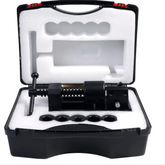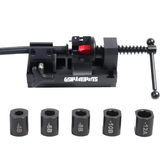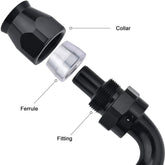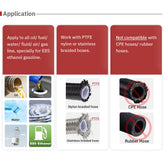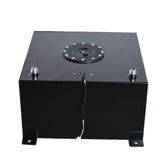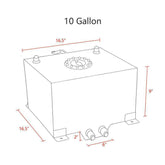Every car's engine gets hot - literally. The combustion process that powers your vehicle generates a lot of heat, which can damage your engine if not properly maintained. That's when your cooling system becomes critical.
This guide will show you how your car's engine cooling system helps keep your engine at the right temperature, ensuring optimal performance and safe engine operation.
What Components Does the Engine Cooling System Consist of?
The engine cooling system in your vehicle is essential for regulating engine temperature and ensuring it runs efficiently. So what are the main components of this system? Here are the seven key components of the engine cooling system and what they do:
- Tubes
- Thermostat
- Expansion Tank
- Coolant Radiator
- Engine Fan (driven by V-belt or Visco®)
- Coolant Pump (either mechanical or electric)
- Temperature Sensor (for engine control or indicator)
Tubes: Tubes are responsible for moving coolant to various parts of the engine and back to the radiator. They are the blood vessels of the cooling system, ensuring that coolant flows freely through the system.
Thermostat: The thermostat is a temperature control device that regulates the amount of coolant flowing to the engine or back to the radiator depending on the temperature of the coolant.
It closes when the engine temperature is low, preventing the coolant from flowing to the radiator, thereby speeding up the engine warm-up time; it opens after the engine temperature reaches the set value, allowing the coolant to flow to the radiator for cooling.
Expansion Tank: The expansion tank is used to store the coolant that expands due to the increase in temperature to prevent the system from over-pressurizing.
It also helps to maintain a stable pressure in the system and replenish the coolant in the system when the coolant temperature drops.
Coolant Radiator: The radiator is the main component in the cooling system that is used to reduce the temperature of the coolant. After absorbing the heat generated by the engine, the coolant flows through the radiator and dissipates the heat to the air through the fins of the radiator.
Engine Fan (driven by V-belt or Visco®): The engine fan can be driven by V-belt or Visco® and is mainly used to force airflow through the radiator when the vehicle is stationary or driving at low speed to enhance the cooling effect.
Coolant Pump (either mechanical or electric): The coolant pump can be mechanically driven or electric, and its main function is to push the coolant to circulate in the cooling system.
This ensures that the coolant can continuously flow from the radiator to the engine and return from the engine to the radiator.
Temperature Sensor (for engine control or indicator): The temperature sensor is used to monitor the temperature of the coolant and transmit this data to the engine control unit (ECU).
This helps regulate the cooling system's operation to ensure that the engine runs at an optimal temperature.
How Does the Engine Cooling System Work?
The main function of the engine cooling system is to keep the engine running within the optimal operating temperature range to prevent overheating and potential damage. Its working principle mainly includes the following steps:
- Coolant circulation: The water pump pushes the coolant and flows from the radiator to the engine.
- Heat absorption: The coolant passes through the engine and absorbs the heat it generates.
- Heat release: The hot coolant returns to the radiator and dissipates the heat into the air through the cooling fins and fan.
- Temperature Control: The thermostat controls the engine's operating temperature by regulating the flow of coolant according to its temperature.
- Recirculation: The cooled coolant is pumped back into the water pump to start a new cycle.
This process is repeated to ensure that the engine runs at the right temperature.
How to Effectively Maintain the Engine Cooling Components?
Maintaining the engine cooling system is a key step to ensure that the engine runs efficiently and for a long time. Here are some basic maintenance guidelines to help you keep your cooling system performing at its best:
- Check the coolant level
Check the coolant level in the cooling system regularly. Make sure the coolant is between the minimum and maximum marks on the expansion tank or radiator. If the level is too low, add the same type of coolant as the original coolant.
- Check the coolant condition
Check the color and texture of the coolant. The new coolant is usually clear, and the color varies depending on the type (usually green, red or yellow). If the coolant becomes cloudy or rusty, this may be due to corrosion inside the system and the coolant needs to be replaced.
- Replace the coolant
Most manufacturers recommend replacing the coolant every two years or based on mileage. This prevents the corrosion and rust inhibitors in the coolant from becoming ineffective and protects the cooling system from corrosion and fouling.
- Check Cooling System Components
Regularly check all cooling system components, including the radiator, water pump, coolant lines, thermostat, and fan. Check for cracks, leaks, or signs of wear.
- Clean Radiator
The outside of the radiator should be clean and free of dirt, leaves, or other foreign matter. These impurities can block airflow, resulting in less efficient cooling.
- Check Radiator Cap
The radiator cap must seal well to maintain system pressure. Check the cap for signs of damage or deterioration and replace it with a new one if necessary.
- Check Fan Operation
Make sure the cooling fan starts properly when needed, especially if the engine temperature rises while the vehicle is running. If the fan is damaged or not operating properly, it should be repaired or replaced promptly.
Conclusion
In conclusion, the engine cooling system is indispensable for preserving your car's engine health and performance. Its components work harmoniously to regulate temperature, ensuring efficient operation and preventing overheating-induced damage.
By understanding its functioning and adhering to regular maintenance practices, such as checking coolant levels, condition, and engine system components, you can effectively safeguard your engine's longevity and reliability.
Engine Cooling System FAQs:
Q1: How often should the coolant be changed?
Coolant should generally be changed every 30,000 to 60,000 miles. In addition, the condition of the coolant should also be checked before an upcoming long trip. This ensures that the cooling system is functioning properly and prevents engine overheating due to aging or insufficient coolant.
Q2: Can I use water instead of coolant in the radiator?
While water can be used temporarily, coolant is recommended because it has a higher boiling point and contains additives to prevent corrosion.
Q2: What are the signs of a malfunctioning water pump?
Signs include coolant leaks, a whining noise from the front of the engine, or an overheating engine.
Q3: How do I know if my radiator needs to be replaced?
Indicators include persistent overheating, coolant leaks, and blockages.
Q4: Can I mix different types of coolant?
This is not recommended because it reduces the effectiveness of the coolant and can damage the engine.
Q5: What should I do if the engine overheats?
Stop the vehicle as soon as it is safe to do so, allow the engine to cool, and check the coolant level and radiator for any obvious problems.

